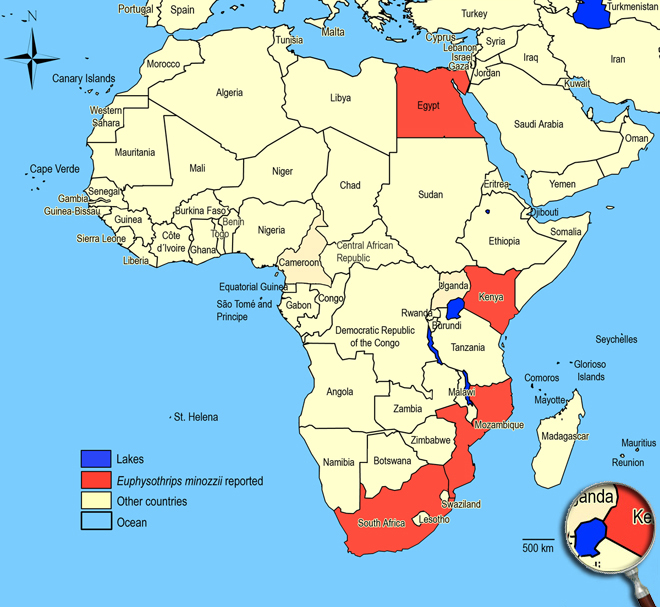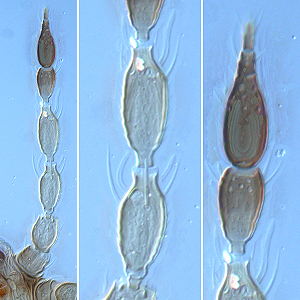Euphysothrips minozzii Bagnall, 1926
Thripinae, Thripidae, Terebrantia, Thysanoptera
Figures
Fig. 1: 8-segmented antenna, segments III and IV with forked sense cone, terminal segments V-VIII
Fig. 2: Head dorsal with ocellar triangle, scape and pedicel
Fig. 3: Head dorsal with pigmented ocelli
Fig. 4: Pronotum
Fig. 5: Meso- and metanotum
Fig. 6: Fore- and hind wing, fore wing basal region
Fig. 7: Sternites III-VI with pore plates (male)
Fig. 8: Tergite VIII with posteromarginal comb
Introduction and recognition
Euphysothrips minozzii breeds on various plants, often on Poaceae. Both sexes macropterous; body color from largely yellow with brown abdominal segments 8-10 to unicolored light brown with paler overtones on pterothrorax and darker overtones on abdominal segtments 8-10; antennal segments I-IV yellow to yellowish brown, V-VIII brown to dark brown; fore wings light grey with a deeper shade in the median third. Antennae 8-segmented; segments III & IV with forked sense cone (Fig. 1). Head with long setae; 3 pairs of ocellar setae, pair III arising on anterior margins of ocellar triangle; 4 pairs of postocular setae, the first and third being twice as long as the second and fourth (Fig. 2 and 3). Pronotum with numerous dorsal setae; 2 pairs of elongate posteroangular setae; 5-6 pairs of stout minor posteromarginal setae (Fig. 4). Metanotum transverse reticulate; median setae arising behind anterior margin; campaniform sensilla present (Fig. 5). Mid and hind tarsi 2-segmented. Fore wing with very long setae on the veins, longest seta twice as long as wing width; first vein with 3 setae distally; second vein with mostly 4 setae (Fig. 6). Tergites II-VII on posterior margin with craspedum of unbroken border or flange; VIII with a complete comb of long, slender and irregular microtrichia (Fig. 8); X with a large longitudinal split. Sternites without discal setae; median setae on sternite VII arising in front of margin.
Male similar to female; sternites III-VII each with a small transverse glandular area medially (Fig. 7).
Taxonomic identity
Species
Euphysothrips minozzii Bagnall, 1926
Taxonomic history
Euphysothrips fungivora Sakimura & Ananthakrishnan, 1962
Anaphothrips (Chaetanaphothrips) fungivora Ramakrishna, 1928
Exothrips madrasensis Ananthakrishnan, 1956
Common name
-
Present taxonomic position
Family: Thripidae Stephens, 1829
Subfamily: Thripinae (Stephens) Karny, 1921
Genus: Euphysothrips Bagnall, 1926
Genus description
The genus Euphysothrips Bagnall, 1926
2 species are listed in this genus. Both are known from India but one, Euphysothrips minozzi, is also recorded in many other countries. The fore wing chaetotaxy is unique in Thripinae, with setae on the veins up to twice as long as wing width (Mound & Ng 2009). Furthermore, the species have 8-segmented antennae with forked sense cone on segements III & IV, 3 pairs of ocellar setae and 2 pairs of long postocular setae on head, no regular series of setae on fore wing veins, tergites II-VII on posterior margin with craspedum of unbroken border or flange, and tergite VIII with a complete comb of long and slender microtrichia.
Species description
Typical key character states of Euphysothrips minozzii
Coloration and body sculpture
Body color: distinctively bicolored or mainly brown to dark brown or mainly pale to yellow, or with some darker markings
Surface of head, pronotum and fore legs: without obvious or with weakly reticulate sculpture
Antennae
Form of sense cones on antennal segments III and IV: emergent and forked on segments III and IV
Number of antennal segments: 8
Antennal segment I: without any setae on dorsal apical margin
Antennal segment II: without an exceptionally long seta at the inner apex
Antennal segment II shape: symmetric
Antennal segment III shape: symmetric
Length of antennal segment III and IV: antennal segment III similar in length to segment IV
Forked sense cone on antennal segment IV: extending to a point at least a third to base of segment V
Antennal segment IV and V: without a hyaline ring near the base
Antennal segment VI bears: not a remarkably dagger-shaped sensorium
Head
Distance between bases of ocellar setae III: greater than width of first ocellus
Head: not prolonged in front of compound eyes
Ocellar setae I: present
Ocellar setae III: arising on anterior margin of, or in front of ocellar triangle
Ocelli: present
Length of postocular setae: alternating short and long setae
Number of ocellar setae: 3
Prothorax
Number of pairs of long anteroangular setae: 0
Number of pairs of long posteroangular setae: 2
Number of pairs of elongate pronotal setae: 2
Number of pairs of posteromarginal minor setae: 5-6
Pronotal blotch or internal apodeme: absent
Pronotum shape: broadly rectangular
Pronotum posteromarginal/posteroangular setae: S2 longer than S3, not equal in length
Mesothorax
Mesosternal furca: with median spinula
Metathorax
Metanotal campaniform sensilla: present
Metanotal median setae: S1 behind anterior margin
Metanotum with dominant sculptured triangle medially: absent
Metasternal furca: without spinula
Shape of metathoracic furca: transverse, V-shaped
Wings
Fore and hind wings: present, more than half as long as abdomen (macropterous)
Fringe cilia arising: from sockets
Fore wing veins: present
Fore- and hind wing surface: covered with microtrichia
Apex of fore wing: with prominent terminal setae
Fore wing anterior margin (costal vein): with setae and cilia but cilia longer than setae
Fore wing costal fringe cilia: arising at anterior margin of wing
Fore wing first vein: distinct from costal vein
Fore wing first vein setal row: incomplete, with setae not closely and uniformly spaced
Fore wing number of setae of second vein: 4
Fore wing second vein setal row: incomplete, with setae not closely and uniformly spaced
Fore wing shape: mainly parallel sided or margins run continuously towards each other
Fore wing surface: not reticulate
Fore wing first vein number of setae on distal half: 3
Fringe cilia on posterior margin near apex: distinctly wavy (undulated)
Length of fore wing costal setae at middle of wing: about twice or more as long as median wing width
Shape of fore wing apex: with mainly posterior margin curved to join anterior margin
Fore wing extreme apex color: pale
Fore wings: alternating bands of dark and light
Legs
Fore tibia: not prolonged around fore tarsus
Mid and hind tarsi: with two segments
Color of fore tarsi: pale or yellow, sometimes apical shaded or brown
Abdomen
Pleurotergites: not covered in microtrichia
Sternite II: with marginal setae but no discal setae
Sternites IV, V and VI: with marginal setae but no discal setae
Sternite VII median posteromarginal setae S1: arising in front of posterior margin
Sternite VII: with marginal setae but no discal setae
Surface of lateral thirds of abdominal tergites: without regular rows of fine microtrichia
Tergites II to VII median setal pair: no more than 0.3 as long as median length of tergite
Tergites IV and V median setal pair: shorter than distance between their bases
Craspedum on tergites IV to VI: present, continuous craspedum
Tergites V to VII: without ctenidia laterally, but sometimes with rows of microtrichia
Craspedum on tergite VIII: without craspedum medially and toothlike microtrichia laterally
Setae on abdominal tergite X: all setae slender
Tergite VIII ctenidia: without paired ctenidia laterally, sometimes with irregular microtrichia
Tergite VIII posteromarginal comb of microtrichia: present and complete medially
Tergite VIII shape of posteromarginal microtrichia: long, slender and irregular or regular
Tergite X: not tubular, longitudinally incomplete

Similar or related species
Euphysothrips minozzii is similar to Arorathrips mexicaus, Chirothrips frontalis, Craspedothrips hargreavesi, Exothrips papyri, and Larothrips dentipes in having more or less a complete craspedum of unbroken border or flange on tergites II-VII, but only in Euphysothrips minozzii craspedum on tergite VIII lacks and is replaced by a complete comb of long, slender and irregular microtrichia. In contrast, other species have a complete craspedum on tergite VIII (except Larothrips dentipes with continuous craspedum medially, but tooth-like microtrichia laterally on tergite VIII), fore wing costal setae shorter or longer than half of median wing width, but never up to twice as long as wing width (like in Euphysothrips minozzi), and no alternating short and long postocular setae on head (Euphysothrips minozzi with alternating short and long postocular setae).
Biology
Life history
As with other thrips species the life cycle from egg to adult is dependent on temperature. The full cycle can take less than one week to over a month and adults may live for more than one month producing several generations in one year depending on seasonal weather (Lewis 1973).
Host plants
On various plants, often on Poaceae.
Vector capacity
None identified, but possible mechanical distribution of phytopathogenic fungi and bacteria.
Damage and symptoms
-
Detection and control strategies
-
Additional notes
-
Biogeography
Indo-Mediterranean, Canary Islands, southern Africa. Egypt (Sinai-Wadi Gedaret; Mariout-Ikingi),
Mozambique (Maputo), South Africa.
African countries where Euphysothrips minozzii has been reported

The species Euphysothrips minozzii was not observed in surveys undertaken in East Africa on vegetables and associated weeds and crops.
Please click here for survey sites of all observed thrips species of Kenya, Tanzania and Uganda.

Bibliography
Ananthakrishnan TN (1956). Studies on some Indian Thysanoptera III. Zoologischer Anzeiger. 157: 130-139
Bagnall RS (1926). Contributions towards a knowledge of the European Thysanoptera. I. Annals and Magazine of Natural History, Zoology, Botany and Geology. (Serie 9) 18: 641-661
Bhatti JS (1972). A study of variation in Euphysothrips minozzii. Entomologist´s Monthly Magazine. 107: 149-150
Lewis T (1973). Thrips: their biology, ecology and economic importance. Academic Press Inc., London Ltd., 349 pp
Mound LA (1968). A review of R. S. Bagnalľs Thysanoptera collections. Bulletin of the British Museum (Natural History), Entomology. Supplement 11: 1-181
Mound LA & Ng YF (2009). An illustrated key to the genera of Thripinae (Thysanoptera) from South East Asia. Zootaxa. 2265: 27-47
Priesner H (1964). A monograph of the Thysanoptera of the Egyptian deserts. Publications de ľInstitut du Desert d´Égypte (1960). 13: 1-549
Ramakrishna TV (1928). A contribution to our knowledge of the Thysanoptera of India. Memoirs of the Department of Agriculture in India, Entomological Series. 10 (7): 217-316
Ramakrishna TV & Margabandhu V (1939). Notes on new and known Indian Thysanoptera. Records of the Indian Museum. 41 (1): 21-33
Sakimura K & Ananthakrishnan TN (1962). A study of the Indian species of the genus Chaetanaphothrips. Bulletin of Entomology. 3: 48-56
Schliephake G (1983). Beitrag zur Kenntnis mediterraner Thripina (Thysanoptera, Thripidae). Deutsche Entomologische Zeitschrift. 30 (1-3): 123-171
zur Strassen R (1969). Neue Angaben zur Thysanopteren-Fauna (Insecta, Thysanoptera) der Kanarischen Inseln. Commentationes Biologicae. 31 (5): 1-74
zur Strassen R (2003). Die terebranten Thysanopteren Europas und des Mittelmeer-Gebietes. Die Tierwelt Deutschlands und der angrenzenden Meeresteile nach ihren Merkmalen und nach ihrer Lebensweise, 74. Teil. Goecke & Evers, Keltern, Germany, 277 pp
----
Web links
Mound´s Thysanoptera pages
Thysanoptera Checklist
ICIPE Thrips survey sites
UNI Halle & Thrips sites
Thrips of California











